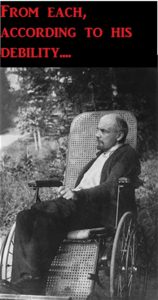Fanny Get Your Gun
 August 30, 1918: Fanny Kaplan Becomes One of History’s Greatest Footnotes
August 30, 1918: Fanny Kaplan Becomes One of History’s Greatest Footnotes
Fanny Kaplan is not the kind of name with any historical portent. In my old neighborhood, I might have known six of them, all friends of my grandmother. None of these elderly yentas would be thought of as Fanny the Great. So, who is the Fanny Kaplan? This one killed Vladimir Lenin. That sounds more erotic than it actually was. Comrade Kaplan actually shot Lenin.
She was a Socialist Revolutionary, a political party more radical than the Bolsheviks. It advocated land distribution to the peasants and terrorism. The Socialist Revolutionaries (let’s be informal and call them the SR) had been in the forefront of resistance to the Tsar–when the Bolsheviks were debating dialectic materialism and playing chess. Furthermore, the SR were just as defiant of Bolshevik tyranny. The SR certainly were more popular than Lenin’s gang. Russia had an election for a constituent assembly in November 25, 1917. With their agrarian platform in a land where 90 percent of the people were peasants, the SR won more than half the seats in the assembly. By contrast, the Bolsheviks came in a distant second. When the Assembly met in January 1918, the Bolsheviks simply disbanded it. The SR had the votes but the Bolsheviks had the guns.
Actually, the SR had guns, too. They attempted an uprising in July 1918. The Bolsheviks crushed it, but the SR still had recourse to political assassination. On August 30, 1918 in Moscow, Lenin was shot twice by Fanny Kaplan. One bullet did no worse than hitting his shoulder, but the other lodged in the neck. He did not die; by contrast, Kaplan’s execution was an immediate success.
However, the Russians were afraid to remove the bullet in Lenin’s neck. At first, ignoring the bullet seemed an effective therapy. Lenin seemed just as effective a tyrant as ever, leading the Reds to victory in a Civil War and initiating an agrarian policy of land distribution which he shamelessly stole from the SRs. (From their ability, to his needs…) Nor had Lenin lost his sense of fun; he sometimes ordered a Politiburo meeting to be conducted in English, German or French. Speaking Russian just wasn’t enough of an intellectual challenge.
But then Lenin began suffering from headaches and insomnia. He was physically deteriorating; the bullet in his neck clearly was threatening his life. So Lenin finally agreed to an operation. No doctor in the Soviet Union had the skill or the nerve; a German specialist performed the surgery in April 1922. The bullet was successfully extracted, and Lenin no longer had headaches and insomnia. However, there may have been one side effect; he had a stroke in May. He seemed to recover from it, but then a second stroke in December left him partially paralyzed. In March 1923, a third stroke left him mute and bedridden. He died in January 1924.
So, Fanny Kaplan killed Lenin, even if it took five years for him to realize it.
Better late than never
In this case, a slow debilitating death was the worst choice. If Fanny had a better aim, the Bolshevik Revolution would have collapsed. Russia likely would have ended up with a second-cousin of the late Tsar or a Slavic version of Francisco Franco. (That is what Russia now has.) But if Fanny had not shot at him, Lenin likely would have lived another 20 years, and Stalin would have remained in Human Resources. In HR, Stalin still could be a psychotic tyrant, but his victims would be considerably less dead.
Interesting! I had never heard of Fanny Kaplan before this.
It take some people five years to get the punchline.
Okay, so what did the Menchevicks think of all that? Thanks for sending it all. Be well, Toddy